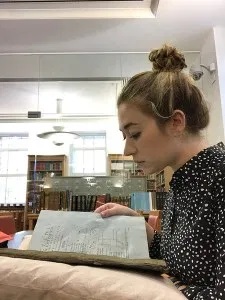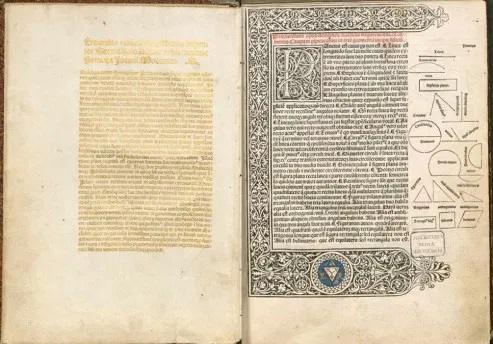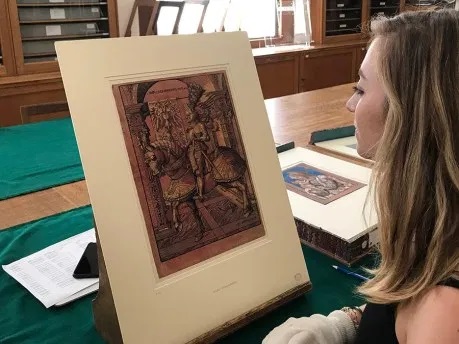Summer Research Report: Emily Anderson

Emily Anderson
Many scholars of the decorative arts turn to books, manuscripts and drawings as source material for their studies. Emily Anderson, a 2017 Trust Summer Research Grant recipient, studies the printed material itself as an artistic endeavor. An alumna of Tufts University and Southern Methodist University, Emily is a doctoral candidate in Art History at the University of Southern California, and has worked at the Museum of Fine Arts, Houston, and the J. Paul Getty Museum. Her dissertation looks at early modern printed materials, particularly from Italy. Despite using early mass-production technology, the printers used unconventional materials to produce bespoke luxury volumes.
“This summer I traveled to museums and libraries in London, Oxford, and Cambridge to examine books and prints made between 1450 and 1600 on the Italian peninsula. While the objects that I consulted are often considered black and white media, during my research trip – made possible by the Decorative Arts Trust – I concluded that this assumption obscures the experimental use of pigments, gold, colored papers, and vellum in books and prints during this time. Printers used the printing press to produce unique or bespoke books using material and visual cues from fine art and manuscripts as well as the decorative arts. Therefore, my project looks at these myriad connections in order to present a new category of object in the early modern period – the bespoke book – and writes a new history of the printing press as a highly experimental instrument.
“The funding from the Decorative Arts Trust allowed me to travel to these locations to see many rare objects that are integral to my project like a copy of Erhard Ratdolt’s first edition of Euclid’s Elements – an ancient Greek text on geometry. Ratdolt, a prominent German printer in Venice, issued the book in 1482, and the British Library holds a copy that was printed on vellum and has a preface printed in gold. Ratdolt used the printing press to imitate the look of manuscripts hand-written on vellum and embellished with gold through mechanical means. He attached gold leaf to the typeset of the preface and prepared the vellum with a resin. The great pressure of the press imprinted the gold leaf onto the vellum in perfect type – the indentations are clearly visible when examining the book first-hand.
“A similar technique is found in northern European prints. At the Ashmolean Museum in Oxford, I viewed a print by Hans Burgkmair of Emperor Maximilian I on Horseback printed with two woodblocks in black and gold from 1508. The raised lines on the woodblock for the gold were brushed with glue, and then gold powder was brushed into the sticky imprint. Additionally, this particular print was made on paper washed in red thereby adding further dimension and distinction to the woodcuts. The colored support ties into yet another aspect of the bespoke book – the practice of printing on blue paper. At Cambridge University Library, I consulted one of two surviving copies of an edition of Euclid’s Elements printed on blue paper issued in 1572 by Camillo Francischini in Pisaro. Like Ratdolt’s copy at the British Library, this blue book tapped into a tradition in prints and manuscripts that used colored supports to enhance the visual impact and economical value of the object. Blue paper and other colored materials changes the way that we perceive the lines, shadows, and modeling of images so it was imperative that I view these objects in person. The Decorative Arts Trust allowed me to do just that and I was able to make more in-depth observations regarding these and many other objects during my trip.”
The Summer research grants such as the one Emily received are awarded each year to graduate students working on a Master’s thesis of PhD dissertation in a field related to the decorative arts. Applications can be downloaded from the Trust’s website, and submitted via e-mail or on-line, and are due by April 30 each year. Questions may be directed to the Trust by phone or e-mail.
About The Decorative Arts Trust Bulletin
Formerly known as the "blog,” the Bulletin features new research and scholarship, travelogues, book reviews, and museum and gallery exhibitions. The Bulletin complements The Magazine of the Decorative Arts Trust, our biannual members publication.









